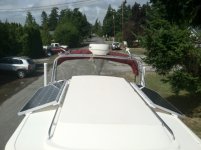Pat,
I've got solar panels for the house and I've done some analysis for them. So bear with me and I've got a question for you.
How many watt hrs/day do you get out of those solar panels? Which I assume is 200 watts mounted horizontally (approximately.) I also assume that your battery meter will give you the watt-hrs pumped into the battery.
First and forgive me for this, solar panels operate on a cosine curve. That is, when the sun line is perpendicular to the panel, the incident angle is 0 deg, and the cosine is 1. The panels are putting out the maximum power. Typically, that's at their rated times some derating factor. For terrestrial panels, that's 15 to 20 % ( Calif's Solar Energy factor.) So as the sun diurnal motion is from the East to the West, the incident angle goes from -90 to + 90 and the power output is a positive cosine curve. The energy is, of course power X time and is the integral of the power cosine from 6 am to 6 pm., since the earth turns 15 deg/hr. That's true if the sun is directly overhead. So allowances should be made for the suns declination and the solar panel mounting angle. If they're flat, that's a factor of the cosine of the latitude, which at Seattle is ~0.7 (~45 deg.) And of course the declination varies with the season.
So, my panels are mounted at an angle of 32 deg, the latitude of San Diego, and as is true for the whole earth, the declination is + 24 deg. At the spring and autumn equinox, I get ~ 7 watt hrs for each watt of solar panel. That takes the Kw-hrs I get per day, and fits the cosine curve at my rated power level. Everything fits withing some degree of approximation.
And if anybody will check my assumptions I would be eternally grateful.
So, 7 watt-hrs X 200 watts X cos (latitude) = 1 Kw-hr/day@ autumnal equinox, which we're approaching. That's my best case estimate. Pat, what are you getting? I'd dearly love to check my assumptions.
Boris



